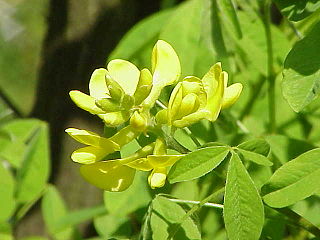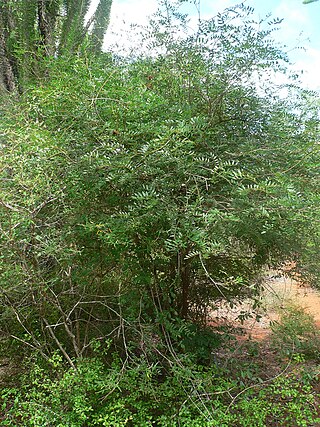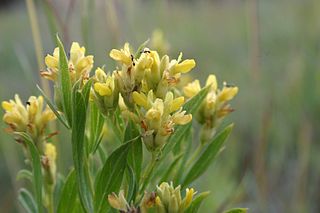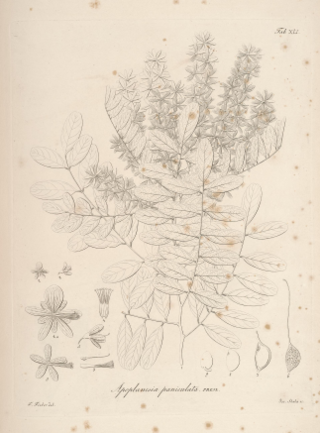
Petteria ramentacea, commonly known as Dalmatian laburnum, is a species of flowering plant in the family Fabaceae. It is a deciduous shrub native to the western Balkan Peninsula, including Greece, Albania, Bosnia and Herzegovina, and Montenegro. It grows up to 3 meters tall, and flowers in May. It grow in shrubland and scrub from 10 to 700 meters elevation, in both sub-Mediterranean and Mediterranean habitats. It belongs to the subfamily Faboideae. It is the only member of the genus Petteria.

Argyrocytisus battandieri, the pineapple broom or Moroccan broom is a species of flowering plant in the legume family, Fabaceae, subfamily Faboideae. It is the only member of the genus Argyrocytisus.
Podocytisus caramanicus is a species of flowering plant in the family Fabaceae. It is a shrub native to the western Balkan Peninsula and southern Turkey. It is the only member of the genus Podocytisus. It belongs to the subfamily Faboideae.

Cordyla is a genus of flowering plants in the family Fabaceae. It includes seven species native to sub-Saharan Africa, ranging across northern Africa from Senegal to Somalia, and through eastern Africa from Sudan to KwaZulu-Natal, including Madagascar.
Haplormosia is a monotypic genus of legumes in the family Fabaceae. Its only species is Haplormosia monophylla, commonly known as Liberian black gum, native to Cameroon, Ivory Coast, Liberia, Nigeria, and Sierra Leone. It is threatened by habitat loss.
Neoharmsia is a genus of legume in the family Fabaceae. It includes two species of trees or shrubs endemic to Madagascar. Typical habitats are seasonally-dry tropical woodland and succulent thicket or woodland, on limestone or coastal sand, in the northern and western parts of the island.
Orphanodendron is a genus of legume in the legume family, Fabaceae. It includes two species of trees native to Colombia, which grow in tropical lowland forest. The genus is in subfamily Faboideae.

Pearsonia is a genus of 12 species of plants belonging to the family Fabaceae and occurring in Africa south of the equator with 1 species found on Madagascar. The species are usually herbs or shrublets with woody rootstocks. Leaves are usually sessile and 3-foliolate. The inflorescence is a congested or lax terminal raceme. The name of this genus commemorates the South African botanist Henry Harold Welch Pearson.

Adenolobus is a genus of African flowering plants in the legume family, Fabaceae. It belongs to the subfamily Cercidoideae.

Barklya is a genus of Australian trees in the legume family, Fabaceae. It belongs to the subfamily Cercidoideae. The sole species is Barklya syringifolia, commonly known as golden crown or golden glory. It grows in rainforest to 20 metres tall. Recorded from Queensland and New South Wales in rain forest. It is often used as an ornamental.
Baudouinia is a genus of flowering plants in the legume family, Fabaceae. It includes six species which are all endemic to Madagascar. It belongs to the subfamily Dialioideae.

Apoplanesia is a genus of flowering plants in the family Fabaceae. It belongs to the subfamily Faboideae.

Calicotome is a genus of flowering plants in the family Fabaceae. It includes five species native to the Mediterranean Basin. The genus belongs to the subfamily Faboideae. It may be synonymous with Cytisus. All species of the genus are thorny shrubs. The ancient Greeks believed that tyrants in Hades were punished by being beaten with the thorny calycotomes.
Disynstemon paullinioides is a species of flowering plants in the family Fabaceae. It belongs to the subfamily Faboideae. It is a liana that is native to Madagascar. It is the only member of the genus Disynstemon.

Eysenhardtia is a genus of flowering plants in the family Fabaceae. It belongs to the subfamily Faboideae. Members of the genus are commonly known as kidneywoods.

Hesperolaburnum platycarpum is a species of flowering plants in the family Fabaceae. It belongs to the subfamily Faboideae. It is the only member of the genus Hesperolaburnum. It is a tree or shrub endemic to Morocco.

Hypocalyptus is a genus of flowering plants in the legume family, Fabaceae. It includes three species of shrubs, subshrubs or small trees native to the Cape region of South Africa. Typical habitats include Mediterranean-climate shrubland (fynbos) at forest margins, in rocky and sandy areas, and along streams, often at high elevations.
Sellocharis paradoxa is a species of flowering plants in the family Fabaceae. It belongs to the subfamily Faboideae. It is native to southern Brazil and is the only member of the genus Sellocharis.

Cytisus nigricans, the black broom, is a species of flowering plant in the subfamily Faboideae of the family Fabaceae. Growing 3–5 ft (0.91–1.52 m) tall, it is a slender deciduous shrub with erect branches. Masses of brilliant yellow, slightly fragrant pea-like flowers appear in long racemes on the current year's growth in summer and early autumn.
Lasiobema was a genus of flowering plants in the legume family, Fabaceae, most of which are lianas, belonging to the subfamily Cercidoideae. It was recently (2010) synonymized with Phanera on the basis of morphology, although this was questioned and it can be treated as a section of this genus.












